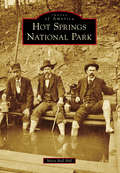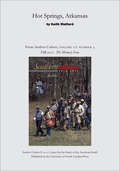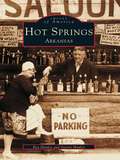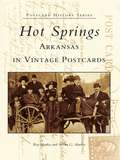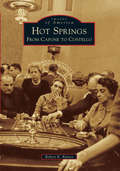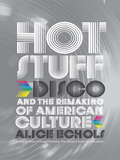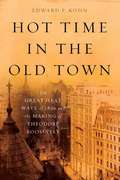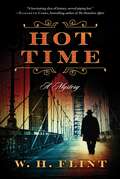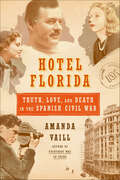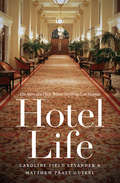- Table View
- List View
Hot Springs National Park
by Mary Bell HillHot Springs was one of the first areas set aside as a federal land reservation in 1832--predating the first national park at Yellowstone by 40 years. In 1921, it was officially designated a national park. Physically the smallest of the 59 US national parks today, Hot Springs measures just larger than 5,500 acres. Its 47 on-site springs produce more than 700,000 gallons of thermal water per day. From early natives who quarried novaculite found in the surrounding hills to famous politicians, performers, and athletes, people have been coming to these springs for thousands of years to partake in the supposed healing powers of the water. Pres. Franklin Roosevelt, boxer Jack Dempsey, and French opera diva Lily Pons are a few of the visitors who made the trek to the "Valley of the Vapors." The history of Hot Springs National Park revolves around peoples' interactions with its thermal water.
Hot Springs, Arkansas
by Keith MaillardHot Springs, Arkansasby Keith MaillardWorld War II-era Hot Springs is the foundation for this author's story, a tale about his family's crumbling dynamics in troublesome times."'Well, of course I remember Pearl Harbor,' my mother says, the tone of her voice adding,What do you think I am, an idiot? She and my grandmother were working in the shop when they heard on the radio that the Japanese had bombed Pearl Harbor. She was five months pregnant with me. It was a Sunday. They'd never heard of Pearl Harbor."
Hot Springs, Arkansas (Images of America)
by Ray Hanley Steven HanleyFrom its rise in the 1800s until well into the twentieth century, Hot Springs was a famed resort known worldwide. The grand hotels and world-class bath houses that sprang up around the government-protected springs drew countless visitors, ranging from the famous and wealthy to those of humble means, all seeking the health and pleasure promised by the Spa City's promoters. In the words of a railroad tourist guidebook from about 1910, "A stay at Hot Springs, be it ever so brief, always remains a pleasant memory afterward. It was the writer's good fortune to spend a few days at this popular resort--not as an invalid, I am happy to say, but as a tourist--and I certainly never bathed in more delightful water than that which flows so abundantly from the hot springs of Arkansas. There is buoyancy, a magnetism about it that is simply indescribable."Such has been the experience of countless visitors over the years. Readers will find much of the history of this storied resort in Hot Springs, Arkansas, which is profusely illustrated with vintage postcards and photographs, all carefully interpreted by the authors, Ray and Steven Hanley, with research assistance from Mark Blaeuer of the Hot Springs National Park staff.
Hot Springs, Arkansas in Vintage Postcards (Postcard History Series)
by Ray Hanley Steven G. HanleyFrom the 1890s to the 1920s, the postcard was an extraordinarily popular means of communication, and many of the postcards produced during this "golden age" can today be considered works of art. Early in the century, Hot Springs was among the most noted resorts in the nation. Its Victorian wonders drew thousands of visitors to partake in the hot mineral waters that bubbled from the earth. In the words written on one card in 1910, "Many people of wealth are here from Chicago and New York. Uncle Billy went to the horse show ball at the Eastman Hotel with an ex-wife of a millionaire. Andrew Carnegie and young Jay Gould were at the ball." Showcased in this fascinating collection are over two hundred postcardsfrom 1900 to 1960. The images are accompanied by the actual penned messages of visitors and extensively researched historical facts.
Hot Springs: From Capone to Costello (Images of America)
by Robert K. RainesIn the late 1800s, Hot Springs, Arkansas, was a small town with a big attraction: hot thermal water. The federal government took possession of the downtown-area springs, and bathhouse row was born, along with the first property that would be considered a national park. Following not too far behind were great entrepreneurs who brought in gambling and prostitution to go with the area's leading industry: moonshining. By the time the 20th century rolled in, Hot Springs was booming with tourists and became America's first resort. In the early 1930s, former New York gangster Owen Madden took up residence in the spa city, and things became very organized. Gangland luminaries from Al Capone to Frank Costello made regular pilgrimages over the next few decades to what was referred to as "the loose buckle in the Bible Belt."
Hot Stuff: Disco and the Remaking of American Culture
by Alice EcholsDisco thumps back to life in this pulsating look at the culture and politics that gave rise to the music. In the 1970s, as the disco tsunami engulfed America, the question, "Do you wanna dance?" became divisive, even explosive. What was it about this music that made it such hot stuff? In this incisive history, Alice Echols reveals the ways in which disco, assumed to be shallow and disposable, permanently transformed popular music, propelling it into new sonic territory and influencing rap, techno, and trance. This account probes the complex relationship between disco and the era's major movements: gay liberation, feminism, and African American rights. But it never loses sight of the era's defining soundtrack, spotlighting the work of precursors James Brown and Isaac Hayes, its dazzling divas Donna Summer and the women of Labelle, and some of its lesser-known but no less illustrious performers like Sylvester. You'll never say "disco sucks" again after reading this fascinating account of the music you thought you hated but can't stop dancing to.
Hot Time in the Old Town: The Great Heat Wave of 1896 and the Making of Theodore Roosevelt
by Edward P. KohnA vivid narrative that captures the birth of the progressive era, Hot Time in the Old Town revives the forgotten disaster that almost destroyed a great American city when one of the worst natural disasters in American history, the 1896 New York heat wave killed almost 1,500 people in ten oppressively hot days.
Hot Time in the Old Town: The Great Heat Wave of 1896 and the Making of Theodore Roosevelt
by Edward P. KohnOne of the worst natural disasters in American history, the 1896 New York heat wave killed almost 1,500 people in ten oppressively hot days. The heat coincided with a pitched presidential contest between William McKinley and the upstart Democrat William Jennings Bryan, who arrived in New York City at the height of the catastrophe. As historian Edward P. Kohn shows, Bryan’s hopes for the presidency began to flag amidst the abhorrent heat just as a bright young police commissioner named Theodore Roosevelt was scrambling to mitigate the dangerously high temperatures by hosing down streets and handing out ice to the poor. A vivid narrative that captures the birth of the progressive era, Hot Time in the Old Town revives the forgotten disaster that almost destroyed a great American city.
Hot Time: A Mystery
by W. H. FlintFor fans of The Knick, The Alienist, and The Last Days of Night, an entertaining, atmospheric crime thriller set in the Gilded Age.New York, August 1896. A &“hot wave&” has settled on the city with no end in sight, leaving tempers short and the streets littered with dead horses felled by the heat. In this presidential election year, the gulf between rich and poor has political passions flaring, while anti-immigrant sentiment has turned virulent. At Police Headquarters, the gruff, politically ambitious commissioner Theodore Roosevelt has been struggling to reform his notoriously corrupt department. Meanwhile, the yellow press is ready to pounce on the peccadilloes of the Four Hundred, the city&’s social elite—the better to sell papers with lurid stories and gossip or perhaps profit from a little blackmail on the side. When the body of Town Topics publisher William d&’Alton Mann is found at the foot of the Brooklyn Bridge, any number of his ink-spattered victims may have a motive.Hot Time is an immensely entertaining, deeply researched, and richly textured historical novel set in a period that reflects our own, with cameos by figures ranging from financier J. P. Morgan to muckraking journalist Jacob Riis. Our guides through New York's torrid, bustling streets are Otto &“Rafe&” Raphael from the Lower East Side, one of the first Jewish officers in the heavily Irish force, who finds as many enemies within the department as outside it; Minnie Kelly, the department's first female stenographer; Theodore Roosevelt himself; and the plucky orphan Dutch, one of the city's thousands of newsboys, who may have seen too much.
Hot Victorians: Meet Your Dream Man From the Past
by Aaron Radford-Wattley'A delicious sepia wet dream of a book that had me drooling, swiping right and wanting to buy a time machine' - Alan Carr'What a treat!' - Dawn French'This book is brilliant fun - capturing the debonair dandyism and sophisticated enigma of some very ruttable gentleman of the time' - Dita Von Teese (Burlesque Queen)Feast your eyes upon the most gentlemanly brows, chiselled jawlines and tightest abs of the Victorian era.Authored by the hugely popular 'Hot Victorians' Instagram account, this book is a brazen celebration of the finest men from the Victorian and Edwardian eras. From a show-off strongman, a hot felon and a daguerreotype dandy to a Swedish sailor and Harvard's first Black graduate, there is a chap for everyone.Divided into chapters such as Hot Dads, Original Hipsters, Jocks and Sexy Nerds, each entry includes a swoon-worthy picture and a dating profile about the man. Among them, meet our cover star Arthur Shidler, dishy doctor and family man from Illinois, or how about the physician responsible for the identification of the bubonic plague parasite - is it really justified that such an ugly bacteria is named after a man so beautiful!? Each entry also includes a hilarious response to one of the prompts you might find on the dating apps, bringing these gents right into the 21st century.Although they may be dead, for these 70+ perfect gents, chivalry is far from it.
Hot Victorians: Meet Your Dream Man From the Past
by Aaron Radford-Wattley'A delicious sepia wet dream of a book that had me drooling, swiping right and wanting to buy a time machine' - Alan Carr'What a treat!' - Dawn French'This book is brilliant fun - capturing the debonair dandyism and sophisticated enigma of some very ruttable gentleman of the time' - Dita Von Teese (Burlesque Queen)Feast your eyes upon the most gentlemanly brows, chiselled jawlines and tightest abs of the Victorian era.Authored by the hugely popular 'Hot Victorians' Instagram account, this book is a brazen celebration of the finest men from the Victorian and Edwardian eras. From a show-off strongman, a hot felon and a daguerreotype dandy to a Swedish sailor and Harvard's first Black graduate, there is a chap for everyone.Divided into chapters such as Hot Dads, Original Hipsters, Jocks and Sexy Nerds, each entry includes a swoon-worthy picture and a dating profile about the man. Among them, meet our cover star Arthur Shidler, dishy doctor and family man from Illinois, or how about the physician responsible for the identification of the bubonic plague parasite - is it really justified that such an ugly bacteria is named after a man so beautiful!? Each entry also includes a hilarious response to one of the prompts you might find on the dating apps, bringing these gents right into the 21st century.Although they may be dead, for these 70+ perfect gents, chivalry is far from it.
Hot Wheels: A Photographic Guide to Life-Size Versions of Your Favorite Die-Cast Cars
by Weldon Owen&“Each car is featured in large, exceptionally fine photos, which show off the lines and details of these fabulous fantasy vehicles, both inside and out.&” —Classic American Every year, the legendary Hot Wheels toy company holds its &“Garage of Legends&” contest, in which fans around America compete to have their unique concept car be the next added to the collection. The contest winners and other unique full-size scale models tour Walmart stores around the country; over 110,000 people attended 2019&’s events. This book collects never-before-seen images and descriptions of these one-of-a-kind cars and the people who design them. The cars featured include: 2001 Twin Mill2003 Deora II1968 Beach Bomb1966 Pontiac GTO1971 Chevrolet El Camino2014 Star Wars Darth Vader Car2005 Ford Sema Mustang GTAnd more!
Hot Winds from Bombay
by Becky Lee Weyrich&“Weyrich writes a sensuous love story!&”—Affaire de Coeur The night Persia Whiddington meets handsome Zachariah Hazzard, they find passion in each other&’s arms. But the heat of their desire is too briefly realized before fate tears them apart. Still, Persia&’s heart remains with Zachariah. Determined to reunite with her true love, the young beauty sets out on a journey from the cold climes of Maine to the sultry heat of Bombay. But can she reclaim Zachariah&’s heart before the imminent dangers of her journey claim her life?
Hot and Heavy (Viking Series II #5)
by Sandra HillIn and out, that's the goal as Lt. Ian MacLean prepares for his special ops mission. He leads a team of highly trained Navy SEALs, the toughest, buffest fighting men in the world and he has nothing to lose. Madrene comes from a time a thousand years before he was born, and she has no idea she's landed in the future. After tying him up, the beautiful shrew gives him a tongue-lashing that makes a drill sergeant sound like a kindergarten teacher. Then she lets him know she has her own special way of dealing with over-confident males, and things get . . . Hot & Heavy.
Hot, Cold, Heavy, Light, 100 Art Writings 1988–2018
by Peter Schjeldahl100 key writings from spanning across thirty years of the acclaimed New Yorker art critic’s career.Hot, Cold, Heavy, Light collects 100 key writings by Peter Schjeldahl spinning thirty years, his last twenty as the art critic of the New Yorker. In this unfailingly lucid guide to an art world in constant, dramatic flux, Schjeldahl addresses new artists and Old Masters with the same pitch of acuity, empathy, and wit. No other writer enhances the reader’s experience of art in precise, jargon-free prose as he does, with reviews that are as much essay as criticism.Implicit in Schjeldahl’s role as a frontline critic is a focus on artists, issues, and events of urgent relevance to the culture at large. Holt, Cold, Heavy, Light tells us why we still care about Rembrandt and Mantegna, Matisse and Picasso; takes the measure of contemporaries Basquiat and Holzer, Polke and Kiefer, Sherman and Koons; introduces us to newcomers Kerry James Marshall and Laura Owens; and salutes rediscoveries of Florine Stettheimer, Hélio Oiticica, and Peter Hujar. The book provides essential knowledge to anyone curious about the character, quality, and consequence of art today.The pieces in Hot, Cold, Heavy, Light were compiled and arranged by the critic Jarrett Earnest, with an ear attuned to Schjeldahl’s range of voices. “The effect of reading him in depth, over time,” Earnest says in his introduction, “is like that of great literature. You come away not only with new insights and ideas, but with a feeling of having been granted an extra life.” “This is a rapturous read for art lovers and all who appreciate dynamic critical essays,” —Booklist“Bruce is no longer The Boss; Peter Schjeldahl is! Hot, Cold, Heavy, Light is the apex of artistic criticism and commentary,” —Steve Martin“The great New Yorker art critic writes like an angel about everyone from Vermeer to Picasso, Donatello to Andy Warhol, in beautiful, enjoyable, accessible essays across 30 years,” —Philadelphia Inquirer
Hot, Hot Chicken: A Nashville Story
by Rachel Louise MartinThese days, hot chicken is a &“must-try&” Southern food. Restaurants in New York, Detroit, Cambridge, and even Australia advertise that they fry their chicken &“Nashville-style.&” Thousands of people attend the Music City Hot Chicken Festival each year. The James Beard Foundation has given Prince&’s Chicken Shack an American Classic Award for inventing the dish. But for almost seventy years, hot chicken was made and sold primarily in Nashville&’s Black neighborhoods—and the story of hot chicken says something powerful about race relations in Nashville, especially as the city tries to figure out what it will be in the future.Hot, Hot Chicken recounts the history of Nashville&’s Black communities through the story of its hot chicken scene from the Civil War, when Nashville became a segregated city, through the tornado that ripped through North Nashville in March 2020.
Hotbed: Bohemian Greenwich Village and the Secret Club that Sparked Modern Feminism
by Joanna ScuttsThe dazzling story of the Greenwich Village feminists who blazed the trail for the movement&’s most radical ideasOn a Saturday in New York City in 1912, around the wooden tables of a popular Greenwich Village restaurant, a group of women gathered, all of them convinced that they were going to change the world.It was the first meeting of &“Heterodoxy,&” a secret social club. Its members were passionate advocates of free love, equal marriage, and easier divorce. They were socialites and socialists; reformers and revolutionaries; artists, writers, and scientists. Their club, at the heart of America&’s bohemia, was a springboard for parties, performances, and radical politics. But it was the women&’s extraordinary friendships that made their unconventional lives possible, as they supported each other in pushing for a better world.Hotbed is the never-before-told story of the bold women whose audacious ideas and unruly acts transformed a feminist agenda into a modern way of life.
Hotbeds of Licentiousness: The British Glamour Film and the Permissive Society
by Benjamin HalliganHotbeds of Licentiousness is the first substantial critical engagement with British pornography on film across the 1970s, including the “Summer of Love,” the rise and fall of the Permissive Society, the arrival of Margaret Thatcher, and beyond. By focusing on a series of colorful filmmakers whose work, while omnipresent during the 1970s, now remains critically ignored, author Benjamin Halligan discusses pornography in terms of lifestyle aspirations and opportunities which point to radical changes in British society. In this way, pornography is approached as a crucial optic with which to consider recent cultural and social history.
Hotbeds of Licentiousness: The British Glamour Film and the Permissive Society
by Benjamin HalliganHotbeds of Licentiousness is the first substantial critical engagement with British pornography on film across the 1970s, including the “Summer of Love,” the rise and fall of the Permissive Society, the arrival of Margaret Thatcher, and beyond. By focusing on a series of colorful filmmakers whose work, while omnipresent during the 1970s, now remains critically ignored, author Benjamin Halligan discusses pornography in terms of lifestyle aspirations and opportunities which point to radical changes in British society. In this way, pornography is approached as a crucial optic with which to consider recent cultural and social history.
Hotel America: Scenes in the Lobby of the Fin-de-Siècle
by Lewis H. LaphamLapham's observations speak to the moral and intellectual confusions visited upon the American ruling elites - in the media and the universities as well as in business and government during the years 1989-1995. Drawn across a broad canvas of incidental and scene. Lapham's sketches take as their occasions events as different from one another as the wars in Panama and the Persian Gulf, the apotheosis of Richard Nixon and the transfiguration of O. J. Simpson, the grim inspections of the American soul conducted by the agents of both the pious left (no smoking cigarettes, no dirty water in the swimming pools, condoms in the schools) and the zealous right (no serial murders in the movies, no lesbians in the army, prayer in the schools), the media's use of history as wallpaper and elevator music, the dwindling significance of President Clinton (vanishing as mysteriously as the Cheshire cat) and the bombastic arrival of Newt Gingrich ("a man for all grievances"), the practice of swindling the stockholders and the art of changing gossip into news.
Hotel Cuba: A Novel
by Aaron Hamburger“Deeply moving, compulsively readable, Hotel Cuba chronicles the early twentieth century immigrant experience with a profound understanding and crackling urgency I’ve not previously encountered. I could not put it down and I could not stop thinking about it long after I’d reached its stunning conclusion. In short: You need to read this book. Right now.”—Joanna Rakoff, bestselling author of My Salinger Year“Thick with the humid air of a Havana summer night, rich with mesmerizing detail, Hotel Cuba will grab you and not let you go.”—Dolen Perkins-Valdez, author of Take My Hand, Balm and WenchFrom the award-winning author of The View from Stalin's Head, a stunning novel about two sheltered Russian Jewish sisters, desperate to get to America to make a new life, who find themselves trapped in the sultry, hedonistic world of 1920s Havana.Fleeing the chaos of World War I and the terror of the Soviet Revolution, practical, sensible Pearl Kahn and her lovestruck, impulsive younger sibling Frieda sail for America to join their sister in New York. But discriminatory new immigration laws bar their entry, and the young women are turned back at Ellis Island. With few options, Pearl and Frieda head for Havana, Cuba, convinced they will find a way to overcome this setback.At first, life in big-city Prohibition-era Havana is overwhelming, like nothing Pearl and Frieda have ever experienced—or could have ever imagined in the rural shtetl where they grew up. As the sisters begin to adjust, their plans for going to America together become complicated. Frieda falls for the not-so-dreamy man of her dreams while Pearl’s life opens up unexpectedly, offering her a taste of freedom and heady romance, and an opportunity to build a future on her own terms. Though to do so, she must confront her past and the shame she has long carried.A heartbreaking, epic family story, Hotel Cuba explores the profound courage of two women displaced from their home who strive to create a new future in an enticing and dangerous world far different from anything they have ever known.
Hotel Dreams: Luxury, Technology, and Urban Ambition in America, 1829–1929 (Studies in Industry and Society)
by Molly W. BergerWinner, 2012 Sally Hacker Prize, Society for the History of TechnologyHotel Dreams is a deeply researched and entertaining account of how the hotel's material world of machines and marble integrated into and shaped the society it served. Molly W. Berger offers a compelling history of the American hotel and how it captured the public's imagination as it came to represent the complex—and often contentious—relationship among luxury, economic development, and the ideals of a democratic society.Berger profiles the country's most prestigious hotels, including Boston's 1829 Tremont, San Francisco's world-famous Palace, and Chicago's enormous Stevens. The fascinating stories behind their design, construction, and marketing reveal in rich detail how these buildings became cultural symbols that shaped the urban landscape.
Hotel Florida: Truth, Love, and Death in the Spanish Civil War
by Amanda VaillA spellbinding story of love amid the devastation of the Spanish Civil WarMadrid, 1936. In a city blasted by a civil war that many fear will cross borders and engulf Europe—a conflict one writer will call "the decisive thing of the century"—six people meet and find their lives changed forever. Ernest Hemingway, his career stalled, his marriage sour, hopes that this war will give him fresh material and new romance; Martha Gellhorn, an ambitious novice journalist hungry for love and experience, thinks she will find both with Hemingway in Spain. Robert Capa and Gerda Taro, idealistic young photographers based in Paris, want to capture history in the making and are inventing modern photojournalism in the process. And Arturo Barea, chief of the Spanish government's foreign press office, and Ilsa Kulcsar, his Austrian deputy, are struggling to balance truth-telling with loyalty to their sometimes compromised cause—a struggle that places both of them in peril. Beginning with the cloak-and-dagger plot that precipitated the first gunshots of the war and moving forward month by month to the end of the conflict. Hotel Florida traces the tangled and disparate wartime destinies of these three couples against the backdrop of a critical moment in history: a moment that called forth both the best and the worst of those caught up in it. In this noir landscape of spies, soldiers, revolutionaries, and artists, the shadow line between truth and falsehood sometimes became faint indeed—your friend could be your enemy and honesty could get you (or someone else) killed. Years later, Hemingway would say, "It is very dangerous to write the truth in war, and the truth is very dangerous to come by." In Hotel Florida, from the raw material of unpublished letters and diaries, official documents, and recovered reels of film, the celebrated biographer Amanda Vaill has created a narrative of love and reinvention that is, finally, a story about truth: finding it, telling it, and living it—whatever the cost.*INCLUDES 16 PAGES OF BLACK-AND-WHITE PHOTOGRAPHS
Hotel Life: The Story of a Place Where Anything Can Happen
by Matthew Pratt Guterl Caroline Field LevanderWhat is a hotel? As Caroline Field Levander and Matthew Pratt Guterl show us in this thought-provoking book, even though hotels are everywhere around us, we rarely consider their essential role in our modern existence and how they help frame our sense of who and what we are. They are, in fact, as centrally important as other powerful places like prisons, hospitals, or universities. More than simply structures made of steel, concrete, and glass, hotels are social and political institutions that we invest with overlapping and contradictory meaning. These alluring places uniquely capture the realities of our world, where the lines between public and private, labor and leisure, fortune and failure, desire and despair are regularly blurred. Guiding readers through the story of hotels as places of troublesome possibility, as mazelike physical buildings, as inspirational touchstones for art and literature, and as unsettling, even disturbing, backdrops for the drama of everyday life, Levander and Guterl ensure that we will never think about this seemingly ordinary place in the same way again.
Hotel Lux: An Intimate History of Communism's Forgotten Radicals
by Maurice CaseyThe extraordinary story of a group of forgotten radicals who found themselves drawn to communist Moscow&’s hotbed of international revolutionary activity: the Hotel Lux. Hotel Lux follows Irish radical May O&’Callaghan and her friends, three revolutionary families brought together by their vision for a communist future and their time spent in the Comintern&’s Moscow living quarters, the Hotel Lux. Historian Maurice Casey reveals the connections and disconnections of a group of forgotten communist activists whose lives collided in 1920s Moscow: a brilliant Irish translator, a maverick author, the rebel daughters of an East London Jewish family, and a family of determined German anti-fascists. The dramatic and interlocking histories of the O&’Flahertys, Cohens and Leonhards offer an intimate insight into the legacies of the Russian Revolution from its earliest idealism through to the brutal Stalinist purges and beyond. Hotel Lux uncovers a world of forgotten radicals who saw their hopes and dreams crash against reality yet retained their faith in a beautiful future for all. Culminating in a queer love story that saw the daughters of the Cohens and Leonhards create an enduring partnership even as their parents&’ political visions crumbled, this is a multi-generational rebel odyssey and a history of international communism, one which looks as much to the future as it does to the past.
